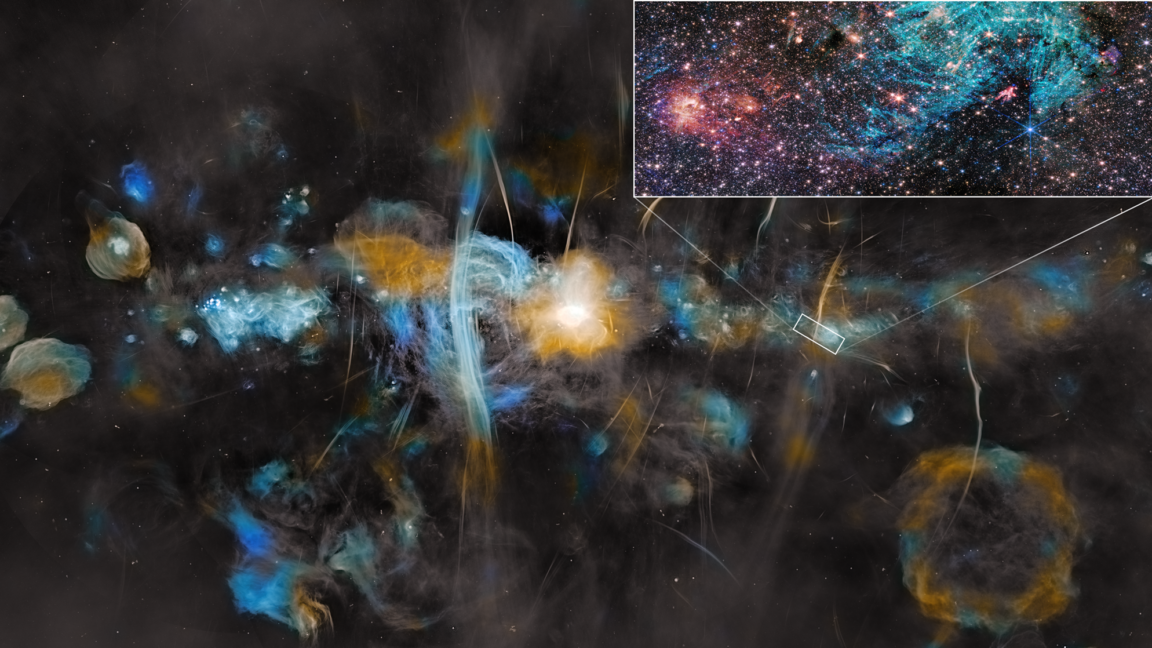Tuesday Telescope: Does this Milky Way image remind you of Powers of 10?
Vertical filaments
Tuesday Telescope: Does this Milky Way image remind you of Powers of 10?
Finding a mystery in Sagittarius C.
Eric Berger
–
Apr 8, 2025 7:15 am
|
8
An image of the Milky Way captured by the MeerKAT radio telescope array puts the James Webb Space Telescope’s image of the Sagittarius C region in context.
Credit:
NASA, ESA, CSA, STScI, SARAO
An image of the Milky Way captured by the MeerKAT radio telescope array puts the James Webb Space Telescope’s image of the Sagittarius C region in context.
Credit:
NASA, ESA, CSA, STScI, SARAO
Story text
Size
Small
Standard
Large
Width
*
Standard
Wide
Links
Standard
Orange
* Subscribers only
Learn more
Welcome to the Tuesday Telescope. There is a little too much darkness in this world and not enough light—a little too much pseudoscience and not enough science. We’ll let other publications offer you a daily horoscope. At Ars Technica, we’ll take a different route, finding inspiration from very real images of a universe that is filled with stars and wonder.
When I was a kid, I was fascinated by the Powers of 10 video, which came out in the 1970s. Perhaps you remember it, with the narrator taking us both outward toward the fathomless end of the Universe and then, reversing course, guiding us back to Earth and inside a proton. The film gave a younger me a good sense of just how large the Universe around us really is.
What I did not know until much later is that the short film was made by the Eames Office, which was founded by the noted designers Charles Eames and Ray Kaiser. It's the same organization that produced the Eames Lounge Chair. It goes to show you the value of good design across genres (shoutout to Ars' resident designer, Aurich Lawson).
Anyway, I say all that because the Power of 10 film continues to live in my head, rent-free, decades later. It was the first thing I thought of when looking at today's image of the Milky Way Galaxy's center. The main image showcases huge vertical filaments, with the supermassive black hole at the galaxy's core clearly visible. This image, captured by a South African radio telescope named MeerKAT, also shows the ghostly, bubble-like remnants of supernovas that exploded over millennia.
On the right of the image, there is a zoomed-in box taken in infrared light by the James Webb Space Telescope, and showing the star-forming Sagittarius C region. An estimated 500,000 stars are visible in this image of the Sagittarius C region. There is also a large region of ionized hydrogen, shown in cyan, that contains intriguing needle-like structures.
We don't really know what those are.
Source: NASA, ESA, CSA, STScI, SARAO, Samuel Crowe (UVA), John Bally (CU), Ruben Fedriani (IAA-CSIC), Ian Heywood (Oxford)
Do you want to submit a photo for the Daily Telescope? Reach out and say hello.
Eric Berger
Senior Space Editor
Eric Berger
Senior Space Editor
Eric Berger is the senior space editor at Ars Technica, covering everything from astronomy to private space to NASA policy, and author of two books: Liftoff, about the rise of SpaceX; and Reentry, on the development of the Falcon 9 rocket and Dragon. A certified meteorologist, Eric lives in Houston.
8 Comments


